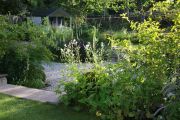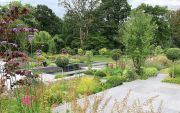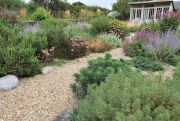How our gardens can help the climate emergency

Gardens and landscapes which support and encourage nature can offer one of the best defences against climate change, and with nearly 23 million domestic gardens in the UK, we really can make a difference to the planet’s future if we work together to harness their full potential.
Garden designers are already rising to the challenge. Last month, the Society of Garden Designers (SGD) held its first Symposium exploring the best ways to create gardens that are good for the environment.
Here, some of its members reveal the impact climate change is already having on the way they are designing gardens and the changes we should all be making to ensure our gardens are as sustainable as they can be.
NOT ALL GARDENS ARE GREEN
Understanding that a garden isn’t automatically ‘green’ is the first step to making a garden more sustainable. ‘Many people want wildlife-friendly gardens’ says Rachel Bailey MSGD, who is the SGD's sustainability expert, ‘but there is a disconnect between their garden and the impact on the climate of the products that go into it.’
Lorenzo Soprani Volpini MSGD and Ana Marie Bull MSGD agree and believe that the key is to demonstrate how small adjustments can make the process more sustainable and eco-friendly. Their approach is to consider the carbon footprint of every product or plant, as well as to use local materials, harvest rainwater where possible and select types of material that are ethically produced.
‘We need to help people understand what being truly sustainable really means’ says Lynne Marcus MSGD and Chair of the SGD. ‘Clients are increasingly asking for more naturalistic gardens, which is positive, but it’s counterintuitive if a large tree arrives on its own truck, is then craned over a building and a digger is needed to get it into a hole.’
RIGHT PLANT, RIGHT PLACE
A well-established principle of gardening, using the concept of right plant, right place - and planting lots of them - is one of the single most important things you can do to increase biodiversity in your garden. Give your plants a happy home and they will thrive.
Andrew Duff MSGD, vice-chair of the SGD, advocates using mainly native species and sourcing from nurseries within 25 miles of the garden so that they easily adapt to their new home. David Stevens FSGD agrees. ‘Certain plants suit certain situations' he says. 'For instance, felty leaves transpire less, broad leaves require greater levels of moisture, stone plants grow on virtually nothing. All plants contribute to the environment, so choose and use accordingly’
‘Designing to maximise biodiversity is a must’ says Rachel Bailey who has increased the number of plants she includes in her designs and suggests layering them up to increase the variety and help create a mini ecosystem. Lynne Marcus agrees. ‘Use a wide palette of plants and as many climbers and hedging plants as possible’ she says, adding that ‘a plant that is suited to its conditions is ‘greener’ than one that isn’t, especially if it largely looks after itself and offers a habitat or food to wildlife and insects.’
THE IMPORTANCE OF TREES
‘However small your garden or allotment, if you have room for just one tree you’ll be doing the world a favour’ says Marian Boswall MSGD, garden designer and author of the book 'Sustainable Garden'.
‘As well as providing habitats, shade and carbon capture, trees are a great addition to a sustainable garden because they provide lots of different types of food for us and for wildlife’ she says. ‘They are also great in cities because they clean the air and reduce the urban heat island effect. Planted on the south of a building a deciduous tree will cool a house in summer and allow sun through in winter. A green air conditioner!’ she adds.
Rachel Bailey advocates planting deciduous trees over evergreen trees if possible, which, she says, offer greater carbon storage over their lifetime. ‘But’, she says ‘evergreen trees and shrubs offer valuable refuge for wildlife too.’ Marian Boswall recommends the crab apple tree as a perfect addition to any garden. ‘Its blossom feeds insects in the spring, and in the depths of winter, when the ground is covered in snow and there is little to eat, its tiny apples provide nourishment for birds’ she says.
MATERIALS MATTER
Choosing materials that are ecologically sound is as important as choosing the right plants, and garden designers are increasingly looking towards local suppliers, as well as recycling existing materials and taking into account the energy used in manufacture, as they adopt a more sustainable approach.
Marian Boswall cites three main things to consider when thinking about hard landscaping: 1. can you reuse what’s there already? 2. Can you reduce the distance new materials have to be transported? 3. What will happen to it in 100/200/1000 year's time? Will it do harm to the ecosystem as it breaks down?
Andrew Duff chooses materials that come from the site or the immediate surroundings but also takes into consideration how they were quarried or made. ‘We think that recycled materials attract a certain look but if you use then in a well-designed space, they can add great character to a new garden’ he says. ‘Look at online community sites, many have materials that are free if you collect them and salvage yards also have a wide range of quality recycled materials.’
Mark Laurence MSGD agrees and says he minimises hard landscaping to a maximum of 20% in his designs. He also creates a lot of gravel gardens, which support the natural water cycle, and advocates using recycled materials where possible. ‘The carbon footprint of anything new will take years to recoup, something existing has already paid its dues.’
‘The best materials to use in landscaping projects are renewable, such as timber or bio-based products or re-purposed materials.’ Says Rachel Bailey. 'The worst material', says Lynne Marcus, 'is plastic grass.'
THE POWER OF EARTH
‘The number of living organisms in just a teaspoon of soil is greater than the number of humans on earth’ says Marian Boswall, making it one of our best defences against long-term climate change. ‘Looking after the soil is vital’ she says, and recommends ‘minimal digging, composting, protecting through mulch and planting in layers to protect its health.’
‘Good soil equals good plants’ says David Stevens ‘and that means understanding and respecting what soil a particular plant or scheme requires. The addition of ample organic material is also essential to improve fertility and soil structure, and remember, this is something which needs to be done on a regular basis and not just during the creation of a garden.’
SIZE DOESN'T MATTER
No matter how big or small they are, what we do with our own gardens does have an impact. Individually, we can all influence the bigger picture.
‘Your garden is one piece of a giant jigsaw’ says Mark Laurence, an analogy echoed by Lorenzo Soprani Volpini who explains how, by creating pockets of greenery in our individual gardens, we can build up green corridors to help increase biodiversity throughout entire neighbourhoods.
‘If all small gardens were paved less and planted more then these very small plots will become a much larger patch and improve connectivity’ agrees Rachel Bailey, who believes that the more people get used to seeing a more natural aesthetic in their neighbours’ gardens, the more normal it will become, ultimately changing how people interact with nature in the wider landscape - whether in their town, city or in more rural areas.
As Andrew Duff points out: ‘Even if you are only attracting one species of bird it is, collectively, a positive and bigger picture’. Lynne Marcus advises applying the same principles as you would to a large garden, just on a smaller scale, as Marian Boswall says: ‘no garden is too small or person too insignificant. Every single action we take makes a difference.’
ADAPT WHAT YOU HAVE
If you’re feeling overwhelmed at the prospect of having to entirely redesign your garden to make it environmentally-friendly, don’t be. Adapting what you have is far more sustainable than the intervention needed to create something from scratch.
Rachel Bailey says that working with existing shrubs, and trees in particular, is much better than ripping out what’s already there and replacing them with new plants. ‘Apart from not taking out something that is otherwise capturing carbon, supporting biodiversity, and regulating soil water for example, you cannot easily replace the maturity of these plants in a garden or buy the character that has been honed through decades of growing in that location’ she says.
David Stevens agrees. ‘Many things, such as an old path or paved area, are part of the history of a place, they are important in many ways and can be successfully blended into the composition to great advantage.’
Andrew Duff advises taking the time to think about what you want to keep at the start of a project. ‘We all too easily remove what is existing in a garden especially when we are new to a site’ he says. ‘Existing trees and other planting can give an instant maturity to a space and will already have created a habitat for lots of wildlife.’
GOOD FOR THE PLANET, GOOD FOR US
Remember, creating a sustainable garden isn’t just about looking after the planet. It’s good for us too.
‘In opting for beauty and sustainability over convenience and expedience, we are improving the health of ourselves and our environment’ says Marian Boswall. She believes that a kind and thoughtful approach to design can help mitigate many of the most important climate issues and in turn help all wildlife – including humans.
‘Gardens are for people’ says Andrew Duff ‘so it’s important to create spaces which people what to spend time in. The design process has always been an exciting mixture of aesthetics and function. Now we must weave in sustainability too.’
The Society of Garden Designers provides access to garden designers right across the UK, offering a complete garden design service including planting plans, hard landscape design, construction drawings and specialist design elements . The comprehensive Find a Designer search facility on the SGD website allows you to search by name, postcode, county or country. www.sgd.org.uk




